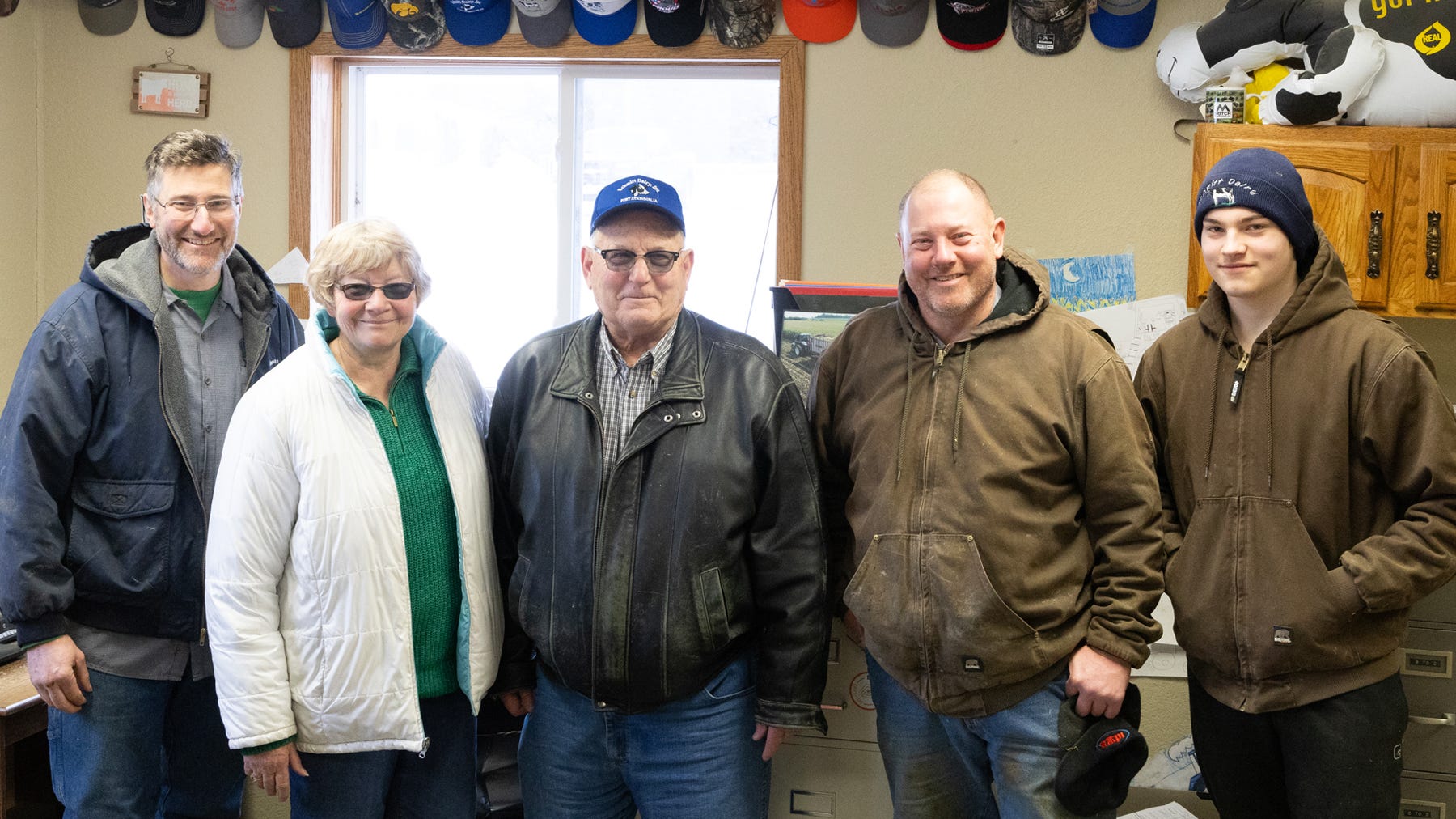
At a Glance
- The 1970s taught Mark Schmitt to feed crops through livestock rather than sell them in the grain markets.
- Milking cows enabled Mark and Diane Schmitt to withstand the tough economics of the 1980s.
- Providing quality dairy products to the consumer is one hallmark of Schmitt Dairy, as is caring for their cattle.
Farm work typically slows in winter, but not at Schmitt Dairy in Fort Atkinson, Iowa, where 600 cows are milked three times daily, and 500 steers and 400 heifers, along with newborn calves, are cared for and fed. Back in 1968, though, the dairy cows numbered just 27.
“From there, we just grew,” says Mark Schmitt, who farms with his wife, Diane, and two sons, Glen and Greg. “It just happened. At one time, we were the biggest dairy in the state.”
The Schmitts have a reputation for expertise in the dairy industry.
“Mark and Diane work closely with their family in a progressive way — from the daily management of the farm, succession planning and forward-thinking ways to leverage themselves financially,” says Jennifer Bentley, Iowa State University Extension dairy specialist. “Dairy farming is a way of life, but this way of life is not always easy. There have been many ups and downs in the industry, and Mark and Diane have persevered with strong qualities of faith, family and community.”
All this — summarized by Bentley’s nomination — is why Mark and Diane Schmitt are honored as 2024 Iowa Master Farmers.
Where it all began
Diane grew up on a dairy farm 5 miles south of nearby St. Lucas. “I didn’t really ever milk, but Mom had chickens, and I’d help pick the eggs and work with the pigs.”
Mark grew up on the home farm, which at that time was a mix of dairy, hogs and chickens.
Both went to school in St. Lucas. “She was a year behind me. I never really noticed her outside of picking on her,” Mark jests.
“That’s why I always thought he was a bully,” Diane shoots back with a smile.
After she graduated from high school, Diane attended nursing school in La Crosse, Wis., as Mark farmed with his father.
They met a few years later at the Inwood Ballroom in Spillville.
“I had this little bet with a friend that I was going to go out with that girl [Diane],” Mark says. “I won the bet.”
They married in 1968 and formed a lifelong partnership. “We started with 27 milk cows, 200 hogs and some chickens,” Mark says. “I had bought one-half of the farm from my dad and farmed that way for the first eight and a half years.”
Diane worked off the farm as a nurse, but she raised all the calves and handled artificial insemination for the dairy before passing these duties off in 2005. Her income helped provide early cash flow to support the farm’s growth.
“That first year, we made about $40,000 in gross income, which at the time wasn’t too bad,” Mark recalls.
In 1969, they started a family with the birth of their daughter, Gail. Daughter Jane and sons Greg and Glen soon followed.
Growth in 1970s
By the mid-1970s, the Schmitts saw they needed to grow if they were to stay dairying. In 1977, Mark’s father sold Mark and Diane 80 acres and all the livestock and equipment on a 10-year contract. They exited hogs and expanded their dairy herd to 120 cows. The Schmitts built a new freestall dairy barn with a double-four herringbone parlor.
The 1980s was a dismal decade for many farmers. However, it was a good one for the Schmitts.
“Those were the best years, because we milked cows,” Mark says. “Our milk price 40 years later is not that much better than it was in the early 1980s.”
Their next major expansion occurred in 1994, as their four children were reaching adulthood. This time, they built a new freestall barn for 500 cows with a double-12 parallel parlor.
Mark and Diane also incorporated their dairy operation, bringing all four children in as minority shareholders.
Two of their children, Greg and Glen, became active members of Schmitt Dairy. Glen joined the farm operation in 1994 after graduating from the dairy management program at Northeast Iowa Community College. He moved into the role of herd manager by 1997, and serves as herd manager and overall manager in his position as president and secretary.
Greg joined the operation in 2005. Today, he is the calf manager and handles all the farm accounting as the farm’s vice president and treasurer.
Since then, the Schmitts also modified their succession and estate plans. They’ve placed farmland into limited liability companies, which family members own in various configurations.

3 GENERATIONS: Diane and Mark Schmitt with sons Glen (left) and Greg, and grandson Henry represent three generations who have worked to make the dairy a success.
As a farm grows, it can encounter more regulations. “We work closely with [the Department of Natural Resources] to manage manure applications to increase soil productivity and ensure safe water in our community,” Mark says.
Expansion often means incurring debt, as was the case in 1977 and 1994. The dairy’s goal is always to nix debt as quickly as possible, within three to five years.
Production and conservation
A veterinarian closely monitors herd health, with semi-monthly herd checks. A nutritionist monitors feeding. Breeding is 100% through artificial insemination. They cull cows as needed, which then go to the sale barn. They sell steers as beef to packing plants when the animals reach 1,500 to 1,600 pounds.
Schmitt Dairy normally grows 900 to 1,000 acres of corn, complemented by 100 to 150 acres of soybeans. It also grows 300 acres of alfalfa and 100 acres of oats as a cover crop and for forage.
The Schmitts adopted this mantra for their farm: Do not allow an ounce of valuable soil to leave the farm.
“We use terraces, CRP [Conservation Reserve Program] filter strips near creeks, crop rotation from alfalfa to corn, and plant in smaller strips,” Mark says. “We use cover crops on some corn acres.”
Tillage runs from no-till on a few acres to minimum tillage on most acres. They test soil every three years on 2.5-acre grids.
Farming is only one part of their operation. The Schmitts have immersed themselves in youth programs, such as 4-H and FFA. They also support dairy industry associations and have offered the farm as a model to others who want to grow their operations. They’ve conducted tours over the years to groups ranging from schoolchildren to adults.
One volunteer program they especially enjoyed was driving the Winneshiek County Moo Mobile for six years before retiring from this activity.
“It was a trailer that has two milkshake-making machines inside,” Mark says. “We went to every town celebration within 25 miles the past two years. I loved it.” Ten of their 16 grandchildren also helped with this activity.
St. Luke’s Catholic Church in St. Lucas plays a big part in their lives. Diane served as a parish board chairperson when the church was made handicapped-accessible by installing an elevator.
“That was my goal when I got on the board,” she says. “There were so many steps up the front of the church, and people were getting older. Now, they can use an elevator. It was a beautiful renovation all around.”
Looking back
Fifty-five years of dairying has generated myriad memories for the Schmitts as they contemplate being named Iowa Master Farmers.
“I would want to be remembered as a good, gentle mother and grandmother,” Diane says. “I also would like to be remembered for being on the church board when it made the church handicapped-accessible.”
“Our mission statement is that the dairy is to produce quality products for the consumer,” Mark says. “It’s to provide the best care possible to the cattle that produce these quality products, and to build a business that succeeds many years into the future. It’s also to promote personal and financial satisfaction for all employees and to maintain financial success.
“I think that we have accomplished a lot of this,” he says. “It’s been a good ride.”

KEEPING BABIES WARM: Newborn calves are housed in a newly constructed calf barn at Schmitt Dairy.
Livestock proves its value
Early in his farming career, Mark learned the value of livestock.
“It was a dry year in 1976,” he recalls. “The land over by the dairy is pretty light soil, so we got absolutely nothing for corn [grain] that year.”
Instead, he cut the corn for silage.
“I kept track of the 90 acres of corn I put in the silo and also 30 acres of alfalfa. That returned $400 per acre when corn [grain] was selling for just $1.60 to $1.70 a bushel. The next year, that same land returned a 150-bushel [per acre] yield, which in 1977 was pretty darn good. I put that corn into storage, and sold it to the government for $1.80 a bushel, or $270 an acre.
“I made more by milking cows with no crop than I did by selling a crop,” he says. “That taught me a lesson. Everything that I grew had to go into cattle feed. That has made this a very successful enterprise.”
Masters at a glance
Name: Mark and Diane Schmitt
Children: Glen Schmitt, Greg Schmitt, Jane Miller and Gail Ramspott
Location: Fort Atkinson, Iowa
Operation: 600-cow dairy with 400 replacement heifers and 500 steers across 1,500 tillable acres
Leadership: Both — Iowa 4-H Foundation Hall of Famers, multiple roles at St. Luke’s Catholic Church from 1968 to 2024 Mark — St. Luke’s parish council president. Diane — St. Luke’s school board president and CCD director, Red Cross blood drive worker for more than 40 years.
Nominator: Jennifer Bentley, Iowa State University Extension dairy specialist
Read more about:
Master FarmersAbout the Author(s)
You May Also Like






